If there was one species of fauna that represented this hike is was the 17-year cicadas. These are in the genus Magicicada.

They were everywhere! Some days we saw and heard more than other days, but every day brought cicadas our way. They are about two inches long with red eyes and transparent wings.

When we were in plentiful areas the vegetation was "alive" with them. They are identified as groups by their emergence cycle. This group is called Brood V (five).

Cicadas are a great insect to get to know. For one thing, they don't bite. They have mouthparts which can be used to suck sap from twigs and branches, but they aren't interested in sucking human sap (they may eat as adults, but mostly it's all about the mating game). They are big and easy to look at. They are great to hold by the wings and let kids look at them. Most kids want to hold them.
The males make a noise to attract females. Unlike crickets and grasshoppers that rub body parts together to produce sound, they have an organ called a tymbal in the abdomen. It is a corrugated portion of the exoskeleton and by forcing air through it the sound resonates. They can change the tone too. Once when I was buzzed really closely by one flying by, it changed sound as it veered away. Another time I picked one up and must have annoyed it because it changed from a low buzz to a high pitched whine.
When they all sing together the noise can be nearly deafening.
The nymphs live underground and get nourishment by sucking sap from tree roots. When the year is right, and the soil temperature at night is above 64 degrees, they bore holes and crawl to the surface.

This was the most fascinating thing to watch.
The nymphs begin to climb up any nearby structure they can find, usually trees or shrubs. Then the back of the nymph splits open and the adults emerge leaving the case behind. This takes a while. Up to four days, I've read.

Then they have to dry their wings. Look at the tips of this one. Still all soft and curled.

This was the closest look I've gotten at cicadas en mass since I was a kid. Pretty neat experience.
 | See Prehistoric Mis-timing? |
| if you like this blog, click the +1 | |
3 comments:
Last year I found one emerging from the casing on a tree in my back yard. It looked like an alien
Haven't seen any for years. Fascinating!
They are what we call "creepy cool." I like weird bugs like that.
So do my frogs. They LOVE cicadas!
Post a Comment